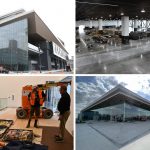Cyclists and pedestrians demand access to the Hoan Bridge
 It’s no secret that the Hoan Bridge is in need of repair. The state has scheduled $350 million in roadway improvements on the bridge to begin in 2013 and south side advocates lobbied hard to keep the bridge in its current high rise bridge configuration, linking south shore suburbs and Bay View with Downtown Milwaukee. As part of that rebuild, bicyclists and walkers are demanding that the bridge have a dedicated lane for their use.
It’s no secret that the Hoan Bridge is in need of repair. The state has scheduled $350 million in roadway improvements on the bridge to begin in 2013 and south side advocates lobbied hard to keep the bridge in its current high rise bridge configuration, linking south shore suburbs and Bay View with Downtown Milwaukee. As part of that rebuild, bicyclists and walkers are demanding that the bridge have a dedicated lane for their use.
If the turnout at the Beulah Brinton Community Center in BayView on Tuesday evening is any indication, there will be a bike/pedestrian lane on the bridge.
Hundreds of people crowded into the conference room of the center to share their thoughts as state Department of Transporation officials, local and state politicians discussed the long-term plans for the Hoan.
Brian Roper, a WisDOT employee and Design Supervisor for the I-794/Hoan Bridge project, said a feasibility study is currently underway concerning the addition of a bike and pedestrian trail over the Hoan Bridge. The study is scheduled to be completed this fall, leaving very little time for public input.
Among the ideas being considered by the DOT are 1) reducing the traffic lanes on the bridge from three to two, allowing for a bike/pedestrian lane in both directions; 2) maintaining three lanes for vehicle traffic and widening the bridge for a bike/pedestrian lane; 3) adding a bike/pedestrian lane to the side of the bridge using a cantilever system; or 4) hanging a bike/pedestrian lane below the current bridge deck.
Roper added that the study will look at the impact of each plan on vehicles, bikes and pedestrians. Among the issues to be studied will be ADA accessibility questions, how a bike/pedestrian option can be integrated into the bridge design, and the cost of having or not having the access.
There is no federal law against having bikes or pedestrians on designated Interstate highways; it is a matter left up to individual states. There is also no law requiring it. However, in 2005, then-President George W. Bush signed a revision to the federal transportation laws that require engineers to consider the addition of bike and pedestrian lanes in all transportation projects, taking into account cost, accessibility and traffic volume.
Milwaukee County Supervisor Patricia Jursik led the effort last year to save the Hoan Bridge from the wrecking ball and a surface street replacement. Now she wants state officials and the public to think big.
“Think big, be brave Milwaukee. I want to be bigger than the Sparta Elroy trail. This could be a big attraction for visitors. This is our Millennium Project,” Jursik said.
Jursik is a member of the county’s lakefront planning committee, formed after the tragedy at O’Donnell Park. She told the crowd that the Hoan Bridge is just the beginning, even indicating that putting a pedestrian/bike trail on the bridge may not be the best idea.
“”I would never say I’m against putting a bike lane on the bridge, but we need to expand 794,” she said. “We need a transportation corridor along the lake – this will become the major local north-south corridor.”
While Jursik is considered a hero for her work to save the Hoan, her idea of expanding an interstate to the south wasn’t what the crowd wanted to hear. They were there to talk about biking and walking on the Hoan, period.
Audience input
Kevin Hardman, Executive Director of the Bike Federation of Wisconsin, called a bike/pedestrian facility on the Hoan Bridge a “once in a lifetime opportunity” to create a landmark route to connect the Oak Leaf Trail and create a great transportation network. He said the 2.5 million bikers in Wisconsin are in favor of the plan and a route on the Hoan would be an investment in building cycling in Wisconsin.
There were a few in the crowd who asked the DOT engineers to not cut the number of lanes on the bridge, pointing out the congestion on the span at times. Those speakers were intrigued by a separate lane hanging under the bridge for bikes and walkers.
But the majority of speakers want a route that went over the bridge. They pointed out the scenery, safety, convenience, health and envirnomental aspects as reasons to open the Hoan to bikers and pedestrians.
A speaker from Whitefish Bay said he regularly bikes in the city, but he refused to ride to the meeting because of the prospect of having to return to his home via S. 1st Street.
“I was mugged two weeks ago and I couldn’t bring myself to do it,” he said. “A route over the bridge would be a safer alternative.”
Dick Knepper, a member of the Bay View Bike Club, said a dedicated lane on the Hoan would be a great visitor draw for Milwaukee. He recounted riding over the Golden Gate Bridge in San Francisco and how our community would benefit financially from something similar.
Another speaker asked the DOT to always consider bikes and pedestrians when engineering projects, as the federal law requires, and called on the plan to eliminate vehicle lanes.
“It is superflorous to have a third vehicle lane since the parkway only has two lanes each way,” he said. “And you should consider this project a way to combat climate change and peak oil prices.”
Charlie Koenan, a Cedarburg resident and employee at Sweetwater Organics, said the news is currently full of stories about a pipeline carrying sludge from Canada to Mexico to extract oil.
“Oil is getting expensive and I’m seeing fewer cars and more and more bicyclists. It makes sense to think about how we can put this path on the bridge,” Kennan said. “Plus, using the bridge is safer and eliminates negotiating those scary intersections.”
Chris Kegel, owner of Wheel and Sprocket, also spoke in favor of bikes on the Hoan.
“I’m look at this as a global economy. In order to be a great community, you need to have a vision and think ahead,” he said. “I am sick and tired of people leaving Milwaukee and going to Portland. This could be a symbol of how great this city can be.”
The discussion went on for two hours and the only opposing comment came from one man who said the whole idea was silly, since he never sees cyclists using the bike lanes on Howard Ave.
So far, the only settled plan with the Hoan is the redecking of the bridge and painting the steel structure, the redecking of the Lake Interchange (at the north end of the bridge) and the replacement of the bridges along the east/west portion of I-794 to the Marquette Interchange. Whether the feasibility study or the public’s comments will lead to a dedicated bike and pedestrian lane on the bridge is unknown, and not a guaranteed deal.

Bikers ride over the Hoan Bridge during this year’s UPAF Ride for the Arts. Bridge photos by Brian Jacobson.
Bikes on the Interstate
There are a number of interstate highway bridges that allow pedestrians and biker use in all parts of the country. Most are located in the west, where vehicular traffic is lighter. There is one in Illinois, however – where I-90 West crosses the Fox River, bike and pedestrian lanes are located below the freeway bridge, similar to the fourth option discussed above.
Other Interstates that have bikes, pedestrians and vehicles sharing the road include the Wonderway Bridge in Charleston, South Carolina and the I-90 bridge over Lake Washington in Seattle. To find more Interstates that allow bicyclists and pedestrians, click here.


















Supv. Jursik called for a “big picture” and her comments about extending 794 are valid and relevant. I’m no fan of willy-nilly roadbuilding, but it’s sensible and will probably happen. I don’t honestly believe current traffic loads warrant 3 lanes each way on the Hoan, but extending 794 means future conditions will. We bikers have nothing to gain by creating an “us or them” conflict with motorists, and I was chagrined to hear pro-bike path speakers comment dismissively about others’ concerns. We need to be flexible.
The Golden Gate Bridge is not/never has been a part of the Interstate system; it is 6 lanes with a movable “soft” center barrier to change the configuration to 4+2 (in either direction) or 3+3, depending upon peak traffic flow; as such, it does not meet Interstate criteria. Your writer should check his research a bit more carefully!
I have a few thoughts on this plan since I use the Hoan Bridge almost every day when I’m not biking to/from work. My first impulse was to think this would be a great idea as I would love a better way to connect downtown to the lake shore however I have some real concerns about the proposal:
1. The winds on the Hoan are consistently very, very strong. So strong in fact that often you can feel the wind trying to turn your car steering wheel while driving. Bike riding is really not enjoyable once you get above a 15 mile an hour head wind.
2. The Hoan would be a pretty steep incline even for experienced bikers which would limit those that can use the bridge. And then a steep decline which would mean people would be racing down at high speeds which would be especially dangerous if there is a bike lane that is shared with cars or would have the potential for bikers running in to other bikers/people.
3. My husband commutes to Brookfield for work every day and during rush hour the 3 lanes on the bridge are jam packed and traffic move incredibly slowly; removing a lane of traffic would create additional un-needed headaches and stress for people and limit the accessibility to our city.
Of the 3 proposals I think only the the path that would be suspended under the bridge would be the only one that might be possible but it would have to be hung pretty low to avoid those very strong winds. I would much rather see an extension of the Lakeshore State Park bike lanes somehow lower to the ground or something different that would be more accessible and highly used by more people (and probably a less costly option?)
Where did you see the writer saying that the Golden Gate Bridge was part of the Interstate system? Am I missing something? I didn’t see the article saying that.
First off, I-794 is NOT a freeway. It is a parkway. The unrealistic low speed limit and abundance of law enforcement prove that. I would be in favor of a below deck bike path. The scenery would be the same as on top of the deck. I doubt it would be enclosed. The only problem with that is that the apex of the arch is pretty low already. There may not be room under the bridge. Another issue is safety. Remember how many accidents with one fatality when the bridge had recent repairs?